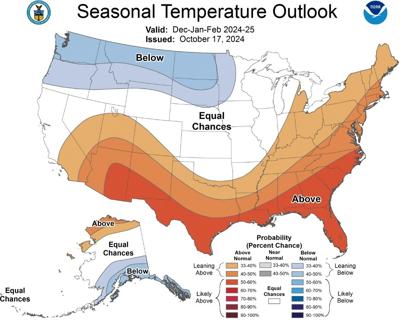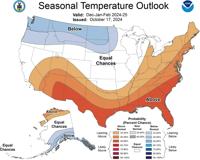This fall, New Hampshire has seen fire but hasn’t seen much rain.
That should change Thursday, when more than an inch of rain is expected. But for the local farm and tourism industries, the weather is always a top concern. Rain between now and the start of winter could affect the ski and maple syrup industries.
“If we don’t get a lot of rain before the ground freezes, I am concerned about the maple crop that requires moisture in the ground,” said Shawn Jasper, the state’s agriculture commissioner.
Maple syrup season, which typically runs from February to April, also requires cold nights and warm late-winter days.
Ski resorts need water sources like ponds to make snow and can’t always rely on the natural stuff. Snowmaking requires weather around 28 degrees or colder.
Temperatures from December through the end of February are expected to be 33% to 50% higher than normal, according to the National Weather Service.
Although higher temperatures don’t necessarily mean less snow, meteorologists predict a normal amount of precipitation this winter.
“There’s a pretty good chance we’re going to see above-average temperatures and really looking at probably a normal winter in regards to precipitation,” said Jon Palmer, a meteorologist at the Weather Service in Gray, Maine.
Will it be snow or rain? No one knows for sure just yet.
A rain check?
With recent red flag warnings for extreme fire danger and a rash of brush fires, drought conditions have been easy to see this fall. Just ask anyone who has raked up leaves to reveal a dust bowl beneath.
This October was the driest in more than a decade in the Manchester area, with only 1.39 inches of rain. October rainfall averages 3.88 inches here. November has been even worse with only 0.12 inches of rain so far, compared with an average of 3.48.
Six out of 10 New Hampshire counties are currently experiencing moderate drought, with coastal Rockingham County suffering from severe drought conditions.
In the Manchester area, five of the last six months have had below the average rainfall.
Despite the lower rain totals this summer and fall, the state’s apple orchards had one of the best years ever, Jasper said. Other crops flourished as well despite irrigation challenges.
Still, he’s concerned a significant drop in maple syrup production could hurt tourism because, like Vermont, New Hampshire is known for high-quality local sugar shacks, which bring millions into the state’s economy.
“It’s just huge for our economy,” he said. “If you take that off the map, it could be a tough year.”
Snow guarantees?
A recent report in The Washington Post says New Hampshire is expected to get less snow than normal because of a combination of factors, including La Niña (cooler than average water near the equator), a marine heat wave off the eastern coast of Japan, a stronger northern jet stream and a weaker southern jet stream.
The Weather Service’s Palmer said all of those factors will affect the wintry conditions here, but predicting snow ahead of time is tricky. Even with the warmer temperatures this winter, you might as well flip a coin.
“Fluctuations in the pattern over the winter, despite there being the warmer temperatures, could lead to above-average snowfall,” he said. “There have been years in the past where we’ve had warmer winters than usual and we’ve gotten pummeled with snow.”
Ski bummer?
Tourism experts and ski resort managers aren’t worried — yet.
“Here in New England, it feels like we see these kinds of predictions annually from different sources, so we don’t really bat an eyelash,” said Jennifer Karnan, director of marketing and sales at Cannon Mountain.
She said Cannon’s snowmaking and grooming teams are accustomed to sporadic temperatures and unpredictable weather patterns.
“We use every opportunity to get out there and capitalize on cold temperatures using high-efficiency equipment,” Karnan said. “It’s about being nimble and adaptable while having a solid strategy for the season.”
Cannon gets ample water for snowmaking from nearby Echo Lake.
At Pats Peak Ski Area in Henniker, General Manager Kris Blomback said every winter is a battle to run a mountain in the southern part of the state. When Pats first opened in 1963, for instance, no one could ski there until late January because of a lack of snow.
That’s why they’ve invested millions of dollars into snowmaking.
“As soon as we get a decent window, in as little as 72 hours, we can get around 10 trails (35% to 40%) of our terrain open and online,” Blomback said.
He said the dry conditions this fall aren’t ideal, but prime snowmaking time won’t arrive for another couple of weeks.
“I’ve been at Pats Peak for the last 35 years, and this isn’t anything that we haven’t seen before,” he said.











